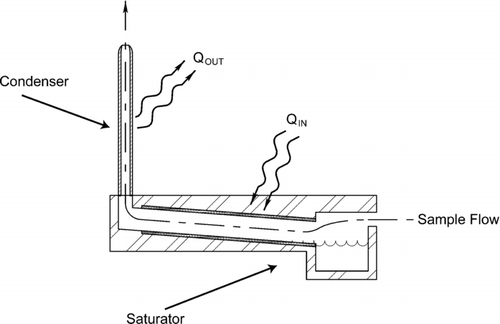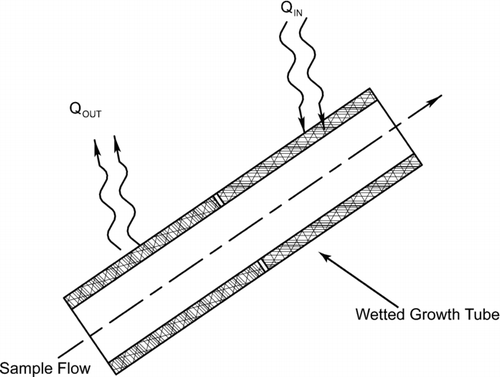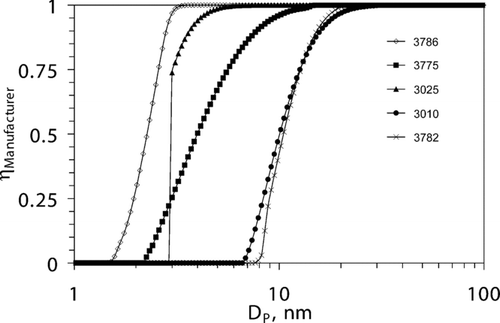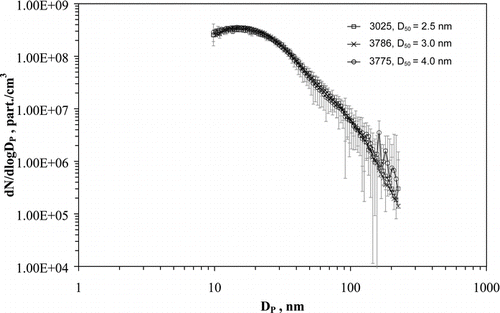Abstract
The introduction of condensation particle counters (CPCs) utilizing water as the condensing fluid provides an alternative to traditional butanol based CPCs. Previous evaluations, using atmospheric and laboratory test aerosols, have verified performance. This study compares the performance of multiple water and butanol based CPC models using a diesel engine exhaust challenge aerosol. A total of 5 CPCs used in a scanning mobility particle sizer (SMPS) configuration were compared. TSI models 3786, and 3782 use water as the condensing fluid while models 3010, 3025A, and 3775 use butanol. The test aerosol was generated by a turbocharged, direct injection diesel engine running at constant speed and load, with two fuels, a low sulfur diesel and 99% soy methyl ester biodiesel fuel. Tests were conducted using a single SMPS platform and switching CPCs for each set of tests. In addition, the tests were repeated with long and nano differential mobility analyzer (DMA) columns. Four of the five CPCs agreed well, giving a standard deviation of the overall average geometric mean diameter of less than 1 nm between the 4 CPCs. The fifth CPC, TSI model 3782 did not agree well with the others. The cause of this disagreement is thought stem in part from the use of water as a condensing fluid, but primarily from a lack of sheath air in the 3782 design. The performance of the TSI 3786, an ultrafine water-based CPC with sheath flow showed far better agreement with the butanol CPCs throughout most mobility diameters.
INTRODUCTION
Continuous-flow, water based condensation particle counters (CPCs) were introduced in 2003 (CitationHering et al. 2005). Along with the obvious difference in working fluid of the water-based CPCs, the thermodynamic approach for achieving supersaturated conditions within the growth section also differs from that of a conventional continuous-flow, butanol-based CPC. This notable difference warrants the validation of water based CPCs under the conditions which they will likely be used.
Worst case performance evaluations of water based CPCs by CitationHering and Stolzenburg (2005), CitationHering et al. (2005), and CitationLiu et al. (2006) reported differences in instrument response to sample aerosols of differing composition. In the same studies instrument response improved when examining challenge aerosols with increased hygroscopicity, thus better suited to growth by water condensation. These studies conclude that most aerosols in real-world environments would be adequately hydrophilic to allow proper particle activation and growth. Field studies near roadways by CitationBiswas et al. (2005) and CitationHering et al. (2005) confirmed the aforementioned hypothesis. More recently CitationMordas et al. (2008) and CitationHermann et al. (2007) found increased D50 with highly pure hydrophobic aerosols but also showed much better performance with the addition of minute hydrophilic impurities.
Ambient atmospheric data from mobile emissions sources has been presented by CitationBiswas et al. (2005) and CitationHering et al. (2005), however, no studies comparing the response of water and butanol based CPCs when challenged with pure combustion aerosols have been conducted.
Particulate matter from diesel engines ranges from less than 5 nm to greater roughly 10,000 nm in mobility diameter and, when examined in the ambient, is distributed trimodally between a coarse, accumulation, and nucleation modes. The coarse mode contains particles on the order of 1000 to 10,000 nm, the accumulation mode from 30 to 700 nm, and the nucleation mode particles are generally less than 30 nm (CitationKittelson 1998). Due to the D50 performance reported by the above authors, challenging the particle counters with nucleation mode aerosols near the instruments specified D50 will provide useful information about their response to combustion aerosols. Diesel particulate matter consists mainly of carbonaceous soot, partially burned hydrocarbons originating from fuel and lubricating oil, sulfates and ash (CitationKittelson, 1998). At light and moderate engine loads partially burned hydrocarbons mainly from lubricating oil are the major constituent, especially in the smallest particles (CitationSakurai et al. 2003). Particulate emissions from biodiesel fueled engines differ from those of diesel and are thought to contain a much higher soluble organic fraction (SOF) due to the higher distillation temperature of the heavier organic compounds contained in the fuel (CitationKnothe 2006). Non-polar compounds like these fuel and oil derived organic compounds may prove sufficiently difficult to activate and grow by condensation of in a water based CPC, and as a consequence demand further study.
Summarizing previous work with water-based CPCs, researchers have shown no sensitivity to particle composition at particle diameters greater than roughly 30 nm (CitationHering et al. 2005; CitationLiu et al. 2006; CitationPetäjä et al. 2006; Herman et al. 2007; and CitationMordas et al. 2008). With the exception of one experiment done by CitationLiu et al. (2006), where a D50 near 50–60 nm was reported using ultra pure emery oil. However, CitationLiu et al. (2006), suggested that this result would not be repeated in the real world because of the rigorous precautions taken to ensure the purity of the emery oil.
This work focuses on the sub 30 nm end of the combustion aerosol size spectrum where problems with the CPCs detecting particles would be most pronounced. Experiments were designed to evaluate instrument response to combustion aerosol with the added demands of rapid response required for scanning operation.
Condensation Nucleus Activation
The ability of any CPC to activate and grow a droplet around a condensation nuclei is characterized by the Kelvin equation (Hinds 1999). A given saturation ratio (S R ) corresponds to a distinct particle size or Kelvin diameter (d*) capable of maintaining mass equilibrium under the stated conditions. Where P d is the partial pressure at the droplet-vapor interface and P S is the saturation pressure of the vapor. This quantity is defined by the material properties, density (ρ), surface tension (γ), and molecular weight along with the temperature of the system (T) and the universal gas constant (R).
CPC Operating Principles
and 2 illustrate the design of butanol and water based CPC growth sections. These schematics are simplified versions taken from the work of CitationAgarwal and Sem (1980) and CitationHering et al. (2005).
Conventional laminar flow CPCs, referred to from this point forward, as butanol CPCs develop supersaturation by heating liquid butanol in the saturating region to a point significantly above the temperature of the condensing region. The aerosol passes through the saturating region and then enters the condensing region where a thermoelectric cooling device drops the temperature, thus lowering the saturation pressure of the system and leaving the previously saturated butanol vapor in a supersaturated condition. This is made possible by the rapid rate of thermal diffusion relative to that of mass diffusion of butanol in air. We know that the Kelvin diameter of a particle varies indirectly with saturation ratio. Increasing supersaturation, by increasing the temperature difference between the saturator and condenser, moves down the minimum particle size that can be activated and grown. This is bounded on the lower end by the onset of homogeneous nucleation (CitationHering and Stolzenburg (2005).
Water based CPCs use a different method to achieve supersaturation. As shown in , the aerosol flow initially enters a conditioning region surrounded by a saturated wall wick, where the temperature is brought to a state below that of the growth region and the relative humidity is brought to 100% by way of diffusive mass transfer from a saturated wall wick (CitationHering et al. 2005). The aerosol then enters a heated growth region, also surrounded by a saturated wall wick, where the saturation pressure of water consequently becomes much higher. According to CitationHering and Stolzenburg (2005) a region of supersaturation results along the centerline of the growth tube, owing to the relatively high rate of mass diffusion of water vapor in air compared with that of thermal diffusion of air.
SMPS Operation
Traditionally CPC counting efficiency is examined with a classified mono-disperse aerosol and gauged in comparison to an aerosol electrometer as described by CitationLiu and Pui (1974) and CitationLiu and Kim (1977). However, due to the more rapid time response required when examining a fluctuating combustion aerosol, a different approach was developed for this study to more closely mimic actual operating conditions. An examination of CPC performance as part of a scanning mobility particle sizer (SMPS; Wang and Flagan 1990) was executed to evaluate the performance of the various CPCs against each other. Additionally CPC performance was normalized via EEPS data, allowing comparison of particle counters collecting data at different times with subtly changing challenge aerosols. Counting efficiencies were compiled in a manner similar to CitationIida et al. (2008) using the lowest D50 CPC as a comparative standard. For this work the TSI 3025 CPC with a D50 of 3.0 nm was used as a comparative standard and each CPC was normalized to simultaneously collected EEPS counts through Equation (Equation2). Where n CPC is the number of counts at each size interval during scanning operation of a given CPC, and n EEPS,t = CPC is the number of counts at the same size interval recorded by the EEPS during the testing of the particular CPC. Examining , it is clear that at mobility diameters above 5 nm the 3025 is well into a regime of 100 per count counting efficiency.
Comparing the performance of particle counters with differing D50 cut points in an SMPS is difficult, but simplified using the TSI Aerosol Instrument Manager (AIM) software provided with the SMPS. With the assumption that the reader is familiar with the physical operation of the SMPS, the data reduction methods of the SMPS software will be discussed below.
Operating as a continuously scanning differential mobility analyzer (DMA; Knutson and Whitby 1975), the SMPS classifies polydisperse aerosols via a force balance between electromotive and drag forces acting on a particle. Electromotive force, described by Equation (Equation3), is a function of the number of charges on a particle (n), the elementary unit of charge (e), and the strength of the acting electric field (E).
Examining Equation (Equation3), the role of particle charge becomes evident. Because the aerosol is routed through a bipolar ionization source, it is initially assumed to have a uniform Boltzmann equilibrium charge distribution and the fraction of particles with a given positive or negative charge at each particle size can be known. This allows estimation of the actual number of particles based upon the counted number of singly charged particles classified by the DMA for a given voltage.
Drag force, F D is then defined through Equation (Equation4) as function of fluid viscosity (μ,), particle diameter (d P ), particle velocity (V), and a slip correction factor (C C ). Equating these two forces allows us to define a terminal velocity for a specific particle diameter when subjected to a given strength electric field. With the DMA flow rate and geometry also known, two forces vectors along with the corresponding DMA geometry allow a trajectory to be calculated. Only particles of this specific mobility diameter will follow the prescribed trajectory and exit the monodisperse outlet of the DMA.
A transfer function as described by CitationWang and Flagan (1990) is also considered in the data reduction, due to the non-uniformity of the particles point of origin, variations in the internal flows leading to variation in particle velocity, and variation in the electric field. The transfer function relates the number of particles of a specified mobility that successfully follow the precisely defined trajectory to the DMA exit, to the actual number of particles of the same mobility following subtly different trajectories slightly short or long of the exit, thus giving a more refined estimate of the total number of particles for that mobility diameter.
The software also has a correction for diffusion losses within the components and associated plumbing of the SMPS. Brownian diffusion leads to significant losses of particles smaller 100 nm as shown by CitationReineking and Porstendörfer (1986). Aside from particle size, residence time within the SMPS flow path is the only input affecting diffusion losses. Each CPC has a specified flow rate, and combining this with the defined geometry of the SMPS enables the software to correct for diffusion losses. Finally, the software compensates for reduced counting efficiency by referencing a counting efficiency curve for each model CPC. If the particle counters are following their expected behavior, the effects of counting efficiency should be fully remedied by this correction. It should be noted that this is a curve based on expected behavior and small variations in specific CPC counting efficiency curves have been reported by CitationWiedensohler et al. (1997). At the smallest particle sizes where counting efficiency based corrections are most pronounced, these small variations in behavior could lead to notable differences in reported counts. For the CPCs used in this work, the counting efficiency curves provided by the manufacturer are shown in .
In principle, these corrections enable the AIM software, regardless of instrument configuration, to theoretically calculate the same particle size distribution, given a uniform aerosol input. The five particle counters used in this work all had a different D50, ranging from 2.5 to 10 nm. It is important to note that at very small particle sizes where diffusion losses are most pronounced and counting efficiency of the instrument is very low, the reported concentrations are highly corrected and based on a few sporadic particle counts. This leads to high sensitivity to false counts and highly inferred data sets which should be closely examined.
EXPERIMENTAL METHODS
Aerosol Generation
Engine exhaust aerosol was generated using a 1999 Volkswagen 1.9 L turbocharged direct injection (TDI) engine with no exhaust after-treatment. The engine was fueled with commercial low sulfur diesel (LSD; < 50 ppm Sulfur) and 99 percent soy methyl ester (SME) biodiesel blended with 1 percent ultra-low sulfur diesel fuel. The main differences between the CPCs is expected to be seen in the smallest particles in the nucleation mode range. With the LSD these particles are expected to be mainly unburned lubricating oil with traces of sulfate but with SME the fuel is likely to play an important role and there is almost no sulfur present (CitationKittelson 1998). These two different fuels were selected in an attempt to give a more diverse set of aerosols for examination. Engine intake pressure, exhaust pressure, load, and speed were monitored and recorded. Coolant, exhaust, oil, and intake air temperatures were also monitored and recorded to ensure uniform engine performance. The test engine was coupled to an eddy current dynamometer and operated at 1200 RPM and 0 Nm. At this condition the engine produces a large nucleation mode with the majority of particle mobility diameters less than 30 nm. A single low load condition was used to ensure significant numbers of particles were available at small mobility diameters. As illustrated by CitationSakurai (2003) and CitationKittelson (1998), moderate increases in load (or Φ) in diesel engines leads to higher concentrations of accumulation mode particles. Consequently, increased numbers of accumulation mode particles give decreases in nucleation mode concentrations due to more effective oxidation and adsorption of precursors to nucleation on the larger particle surfaces. The dilution ratio corrected total particle number concentration is roughly 108particles/cm3, the majority of which are less than 30 nm in mobility diameter. Diluted aerosol concentrations measured by the SMPS are about 105 particles/cm3, with individual channels measured by the CPCs on the order of 103 to 104 particles/cm3.
Exhaust Dilution and Sampling
A two stage, micro-dilution system, similar in design to the system characterized by CitationAbdul-Khalek (1999), was used to dilute engine exhaust to concentrations acceptable for sampling by the aerosol instrumentation. Dilution ratios were calculated using NO concentrations throughout the dilution system. NO was measured with a CAI 600 series NO/NO X analyzer and a Monitor Labs high sensitivity NO/NO X analyzer. The ranges of these instruments are 0–1000 ppm or 0–100 ppm, and 0–10 ppm, respectively. Primary dilution ratios were approximately 15:1 and secondary dilution ratios were about 20:1. The total dilution ratio ranged from 230 to 300 and was recorded periodically throughout the testing. Dilution tunnel temperature was held at 47°C through PID controlled heating of primary stage dilution air. Compressed air used for dilution was HEPA filtered and dried prior to introduction into the dilution system.
illustrates the aerosol sampling system which is comprised of the SMPS, Engine Exhaust Particle Sizer (EEPS), micro-dilution system, and NO X analyzers. Before beginning data acquisition with each SMPS configuration the instrument flows were set and the zero was checked. Sheath and aerosol flows were set and confirmed in the following manner. First, aerosol flow was measured using a Gilibrator that was placed inline between the CPC and the differential mobility analyzer (DMA, Knutson and Whitby 1975) aerosol outlet to accurately characterize the flow of the system. An average of 10 measurements was used to determine the aerosol flow. The internal flow meter of the SMPS was then used to set a sheath flow at a 10:1 ratio. illustrates the process and shows the sample aerosol path to the SMPS and EEPS. After the flow check, the Gilibrator was removed from the SMPS, a HEPA filter was connected to the instrument inlet, and a scan was executed to ensure the system was leak free and the instrument would properly zero.
Simultaneously the engine and EEPS were turned on and warmed up until stable operating temperatures were reached. After the SMPS flow calibration and zero were completed, data acquisition began for that configuration. The first scan was a long duration scan of 300 s. Five sets of data were then taken consisting of a 90 s upscan and 30 s downscan. The long scans were compared with 90 s scans to confirm the default delay time given by the SMPS software. After taking 5 sets of data a different CPC was installed and the flow calibration and zero steps were repeated.
summarizes the CPCs used and their pertinent specifications. CPCs with 50% lower counting efficiencies (D50) ranging from 2.5 nm to 10 nm are examined with the two water based CPCs located near both ends of that range. All CPCs were operating in agreement the manufacturer's specification.
TABLE 1 Specifications of the five CPCs studied
The CPC and DMA combinations tested, along with the fuel and engine condition, are shown in . Employing a single SMPS platform throughout the testing, CPC and DMA components were interchanged while the engine was maintained at a constant operating condition. The tests were repeated with both a long-DMA (TSI 3081) and a short or nano-DMA (TSI 3085) (CitationChen et al. 1998). To summarize the test matrix, the five CPCs were paired with both the long and nano-DMA in an SMPS configuration for each fuel. To ensure a continuously stable test aerosol, diluted exhaust was sampled continuously using the EEPS (TSI 3090) throughout all tests.
TABLE 2 Matrix of SMPS configurations, engine conditions and fuels used for testing, n = 5 for each of test
To minimize the effects of line losses on aerosol samples, the aerosol path from the outlet of the second stage dilutor was kept as short as practical, roughly 1 meter, and carbon impregnated conductive silicone tubing was used. For each set of tests the sample line length was the same.
RESULTS AND DISCUSSION
Presented below are particle size distributions collected over the course of 4 days of testing. Size distributions are shown grouped by CPCs with similar D50 cut points, CPCs 3010 and 3782, followed by CPCs 3025A, 3775, and 3786. The multiple charge and diffusion corrections available in the software were used in all cases. The error bars shown in the figures were established with 95% confidence using a t-distribution with a sample size of five.
Low Sulfur Fuel Size Distributions
through 8 show 10 particle size distributions collected with 10 configurations of an SMPS. These data result from sampling the exhaust of a diesel engine running on LSD. and 6 show the results of the SMPS configured with the long-DMA sampling engine exhaust. It is clear from that there is better agreement among the lower cut point, or ultrafine, CPCs. In , the D50 = 10 nm CPCs exhibit a substantial divergence in their reported size distributions near 15 nm. This divergence is attributed to both particle counters as neither shows good agreement with the ultrafine CPC size distributions shown in . The increase in concentration at lower mobility diameters shown by the 3010 in is likely due to the specific CPC exhibiting better counting efficiency than the average counting efficiency curve expected by the software. The divergence in particle concentration at 15 nm for the 3010 CPC is also observed in , , and . Again, it is believed that over correction for counting efficiency due to over performance of the CPC is the most likely explanation. Interestingly the phenomenon is not seen with any tests using the 3010 with the nano-DMA, the cause of this inconsistency is not fully understood.
FIG. 5 Size distributions of LSD fueled combustion aerosol, SMPS comprised of a long-DMA and each of 2 D50 = 10 nm CPCs, 95% CI, n = 5.

FIG. 6 Size distributions of LSD fueled combustion aerosol, SMPS comprised of a long-DMA and each of 3 ultrafine CPCs, 95% CI, n = 5.
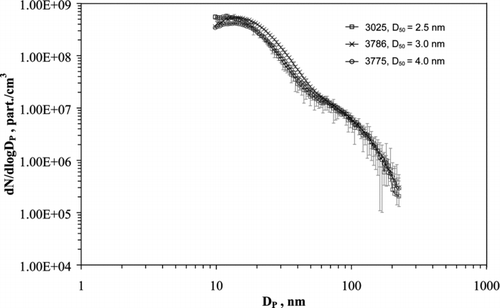
In the 3782 undercounts at mobility diameters below roughly 15 nm and exhibits a much more rapidly decreasing size distribution on the lower mobility diameter side than any of the other CPCs. This behavior, which is thought to be a product of aerosol hygroscopicity, and the inability of the water based CPC to activate these small particles, is less pronounced but can also be seen as the ultrafine water-based CPC approaches its lower cutoff, 2.5 nm, in . When the long-DMA obtained size distributions are examined in and , the ultrafine water based CPC is never operating near its lower cutoff, thus well above its designed Kelvin diameter. In these cases the size distributions resolved by the water based 3786 very closely match those of its butanol counterparts through the entire range of mobility diameters. and re-evaluate the same aerosol with a TSI model 3085 nano-DMA column in place of the long-DMA previously used in the SMPS. Again differences in the reported concentration between the 3010 and 3782 are seen at mobility diameters below 15 nm. A mode is apparent with the 3010 at 13.2 nm agreeing closely with the results from the ultrafine CPCs.
FIG. 7 Size distributions of LSD fueled combustion aerosol, SMPS comprised of a nano-DMA and each of 2 D50 = 10 nm CPCs, 95% CI, n = 5.
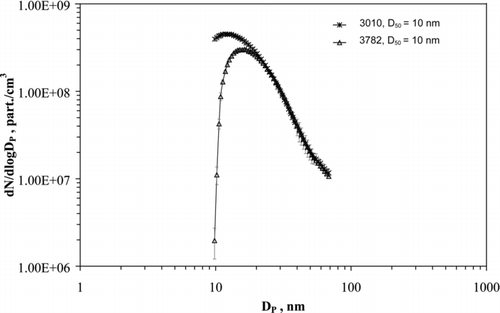
FIG. 8 Size distributions of LSD fueled combustion aerosol, SMPS comprised of a nano-DMA and each of 3 ultrafine CPCs, 95% CI, n = 5.
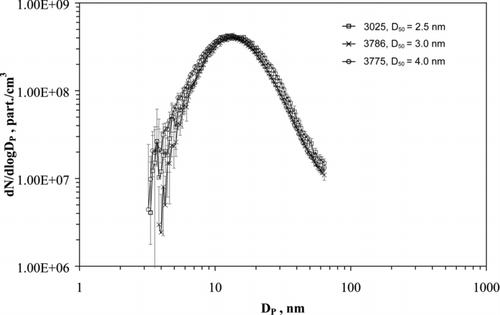
through show results for the same set of tests that were conducted with LSD fuel, however, with the engine running on SME fuel.
Soy Methyl Ester Fuel Size Distributions
Greater variation in reported aerosol size characteristics was observed when the SME fuel was used. We believe that the larger observed range of reported values resulted from the engine's thermostat cycling throughout the testing. This caused the engine operating temperature to fluctuate, resulting in a variable signature to the exhaust particle size distribution. The total volume concentration reported by the EEPS throughout testing shows a standard deviation below 10% for each test series except those utilizing SME fuel and the nano-DMA. For this set of tests the standard deviation in total volume concentration was 31%. Examining and , the differences in total volume concentration are a manifestation of the differing concentrations seen in the larger mobility diameters. The coolant temperature fluctuated within a range of 12°C about the operating temperature of 85° C during this testing. Much more stable operation was seen throughout the long-DMA and SME testing with a coolant temperature range of 4°C about the operating temperature. Significant variation in exhaust aerosol number distributions due to temperature has been documented by CitationAakko and Nylund (2003) when examining cold start conditions at different temperatures.
FIG. 11 Size distributions of SME fueled combustion aerosol, SMPS comprised of a nano-DMA and each of 2 D50 = 10 nm CPCs, 95% CI, n = 5.
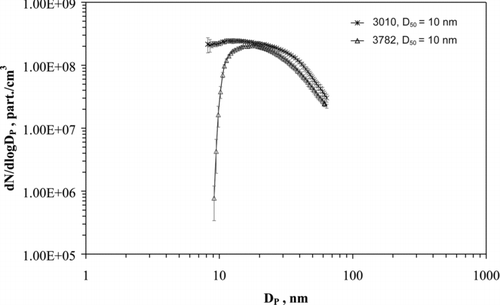
FIG. 12 Size distributions of SME fueled combustion aerosol, SMPS comprised of a nano-DMA and each of 3 ultrafine CPCs, 95% CI, n = 5.
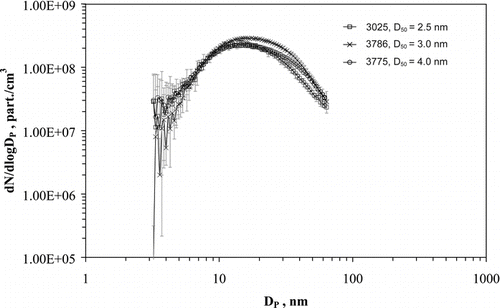
FIG. 13 Derived Counting efficiencies of 4 CPCs with respect to the 3025 ultrafine CPC, 95% CI, n = 4.
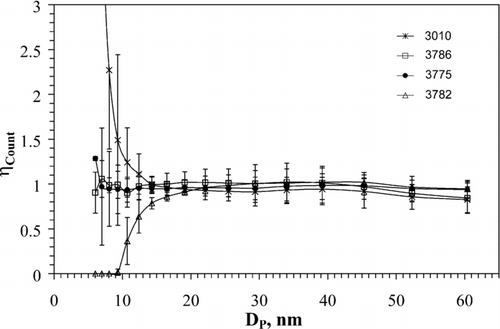
and show SMPS data collected with the long-DMA configuration and the engine fueled on SME. The figures are organized as before, with the D50 CPCs shown on the first plot and the ultrafine CPCs on the second. The same divergence below 15 nm as reported previously between the 3010 and 3782 for the LSD was observed. The increasing trend of the 3010 aerosol concentration below 15 nm is again thought to be an artifact of counting efficiency over performance. Comparison of the 3782 data with the ultrafine CPC data in , shows under counting of particle concentrations below 15 nm. The agreement between the ultrafine CPCs in is good throughout the range of mobility diameters examined. and re-examine the SME fueled combustion aerosol with an SMPS employing the nano-DMA as was done for the LSD tests. It is in these figures that variation in engine temperature is prevalent.
SUMMARY STATISTICS
The calculated aerosol size statistics for all tests are shown in . Referring to , it can be seen that the selected size range differs based on the CPC and DMA combination used. To maintain consistent inputs, only the overlapping size range of the CPCs was used for calculating the summary statistics, with a unique range identified for each DMA. For the nano-DMA the range is 3.22 to 63.8 nm and for the long-DMA the range is 9.82 to 224.7 nm.
TABLE 3 Summary of reported particle size statistics for 5 CPCs used in an SMPS configuration to examine combustion aerosol from 2 different fuels, upper and lower 95% confidence limits are presented as a percent of the mean value
LSD fuel shows geometric mean diameters (d g ) that agree well across four of the five CPCs ranging from 13.2 to 14.3 nm for the nano-DMA (3085) configuration and from 16.2 to 17.3 nm for the long-DMA (3081) configuration. The 3782 measured larger values, 19.1 and 18.5 nm, respectively. The average d g calculated for the 4 CPCs with closest agreement is 13.9 nm with a standard deviation of 0.62 nm for the nano-DMA configuration and 16.6 nm with standard deviation of 0.7 nm for the long-DMA configuration but recall that it is expected that d g will not be the same for two DMAs because of different averaging intervals. The interval shown with each d g in was established with 95% confidence using five samples taken with the specific CPC and DMA combination.
This increased variation observed in the SME test cases is reflected in the range of geometric mean diameters reported by all the CPC/DMA combinations and the larger confidence intervals established for specific combinations. The 3010, 3025, 3775, and 3786 CPCs data resulted in an average d g of 16.2 nm with a standard deviation of 0.8 nm in the nano-DMA configuration and an average of 17.3 nm with a standard deviation of 2.5 nm in the long-DMA configuration.
In order to minimize any effects of a variable accumulation mode due to the engine fluctuations discussed above, a lognormal curve was fit to only the nucleation mode of the data. The modes of the curve fits are presented along with the software calculated modes in . It is clear that ignoring the accumulation mode particles causes a downward shift in d g as should be expected. The same general trends are mirrored in the curve fit data with the 3782 consistently showing the largest d g . Again, an average d g was computed from the four CPCs in closest agreement. Examining the curve fit derived d g computed for both fuels we can see less difference between the nano-DMA reported d g and long-DMA reported d g than is present with the AIM data. This is explained by extended upper range of the long-DMA. The AIM derived data calculates a d g based on all measured concentrations, however the majority of the accumulation mode is outside the range the nano-DMA, thus its contributions are only reflected in the long-DMA data.
TABLE 4 Summary of d g reported by software compared with a lognormal curve fit of the nucleation mode only
The SMPS employing the 3782 consistently reports the lowest concentration in each of the groups of data. In , 95% upper and lower confidence limits are presented as a percent of the mean value of the five measurements collected with the specified SMPS configuration. Combining this underreported concentration and overestimated d g , it can be concluded that the 3782 is undercounting particles on the small end of the size distribution, this is also shown clearly in , , , and . These trends are not reflected in the data collected with the ultrafine water-based CPC, model 3786. CitationHering and Stolzenburg (2005) examined saturation profiles across the radius of the growth tube in water based CPCs and found saturation ratios decaying from maximum values at the center line of the growth tube to about 1 at the walls. Without the sheath flow used in the 3786, the overall ability of the 3782 to activate and grow the smallest particles may likely suffer due lower average saturation ratios across the diameter of the growth tube. Throughout most mobility diameters, the 3786 based SMPS data exhibits good agreement with the butanol CPC based SMPS data for all test cases as can be seen in .
Derived Counting Efficiencies
Counting efficiencies corresponding to four of the particle counters were calculated against the 3025 CPC through the methodology described in Equation [2]). A single efficiency is presented for each CPC. It is an average efficiency calculated with data from both the long and nano DMAs and LSD and SME fuels. Each of these combinations gives a total of four samples through which a 95% confidence interval was established using a t-distribution.
The counting efficiency curves show particle mobility diameters ranging from 6.4 nm to 60.4 nm. The range is bounded on the lower end by the capabilities of the EEPS and the upper end by the default SMPS sizing range given by the software. Here again, the 3782 shows significant undercounting in the range below 15+ nm. Recall that this data is complied from data that is corrected for CPC counting efficiency, DMA transfer function, diffusion losses, and equilibrium charging. The over counting behavior of the 3010 is also clearly displayed.
CONCLUSIONS
Five condensation particle counters were studied as part of a SMPS in an effort to examine the effectiveness of water based CPCs for the study of combustion aerosols. TSI models 3782 and 3786 water based particle counters, along with models 3010, 3025A, and 3775 butanol CPCs were coupled with both a long-DMA (TSI 3081) and nano-DMA (TSI 3085) and used to measure a constant output combustion aerosol. The CPCs were separated into groups with similar D50 for analysis in order to accurately draw conclusions pertaining to performance based on working fluid. Two challenge aerosols were generated with a 1999 Volkswagen 1.9 L turbocharged direct injection (TDI) engine with no exhaust after-treatment. This engine, offered until 2004 was one of the very limited choices for diesel powered passenger cars in the United States during this time period. Thus it is highly representative of the diesel powered passenger fleet that is on the road today. The first fuel utilized was low sulfur diesel fuel, and the second, soy methyl ester biodiesel.
Although the 3782 water based CPC did not perform as expected, the 3786 water based CPC performed on par with its butanol counterparts throughout most mobility diameters. However it did exhibit some degree of undercounting as particle mobility diameters approached the lower size cutoff of the instrument for both diesel exhaust and biodiesel exhaust aerosols. Due to this behavior the instrument appears to show some sensitivity to particle composition when operating under the most demanding conditions for condensation and growth. The significant undercounting of the 3782 is likely caused by lower average saturation ratios within the growth tube. This is a direct result of the lack of sheath flow that is present in the other water based CPC, model 3786. The performance of the 3786 throughout most mobility diameters agreed with previous works that showed major deviations from butanol CPC performance would only be encountered with highly pure hydrophobic aerosols. The major deficiencies encountered with the 3782 CPC are thought to be problems with the growth tube design, and due to the performance of the 3786 are not issues arising solely from the use of water as a condensing fluid.
It should be noted that prior to the research conducted here the 3010 was freshly received from a factory calibration. The 3782 was recently purchased with the proper certificate of calibration. The 3775 and 3786 models were also recently received on loan from the manufacturer with calibration/certification records and assumed to be in good working condition. The internal flows of the 3025A were calibrated per the manufacturer's instructions and all CPCs inlet flows and component temperatures were well within specification.
Acknowledgments
This study was supported in part by a grant from the Initiative for Renewable Energy and the Environment (IREE). Additionally we would like to thank TSI, Inc. for the loan of the CPCs evaluated in this study.
REFERENCES
- Aakko , P. and Nylund , N. Particle Emissions at Moderate and Cold Temperatures Using Different Fuels . Powertrain & Fluid Systems Conference & Exhibition . Pittsburg , PA .
- Abdul-Khalek , I. , Kittelson , D. B. and Brear , F. The Influence of Dilution Conditions on Diesel Exhaust Particle Size Distribution Measurement . International Congress and Exposition . Detroit , MI .
- Agarwal , J. K. and Sem , G. J. 1980 . Continuous Flow, Single-Particle-Counting Condensation Nucleus Counter . J. Aerosol Sci. , 11 : 343 – 357 .
- Biswas , S. , Fine , P. M. , Geller , M. D. , Hering , S. V. and Sioutas , C. 2005 . Performance Evaluation of a Recently Developed Water-Based Condensation Particle Counter . Aerosol Sci. Technol. , 39 : 419 – 427 .
- Chen , D. , Pui , D. Y. H. , Hummes , D. , Fissan , H. , Quant , F. R. and Sem , G. J. 1998 . Design and Evaluation of a Nanometer Aerosol Differential Mobility Analyzer (Nano-DMA) . J. Aerosol Sci. , 29 : 497 – 509 .
- Hering , S. V. and Stolzenburg , M. R. 2005 . A Method for Particle Size Amplification by Water Condensation in a Laminar, Thermally Diffusive Flow . Aerosol Sci. Technol. , 39 : 428 – 436 .
- Hering , S. V. , Stolzenburg , M. R. , Quant , F. R. , O'Berreit , D. R. and Keady , P. B. 2005 . A Laminar-Flow, Water-Based Condensation Particle Counter (WCPC) . Aerosol Sci. Technol. , 39 : 659 – 672 .
- Hermann , M. , Wehner , B. , Bischof , O. , Han , H. , Krinke , T. , Liu , W. , Zerrath , A. and Wiedensohler , A. 2007 . Particle Counting Efficiencies of New TSI Condensation Particle Counters . J. Aerosol Sci. , 38 : 674 – 682 .
- Iida , K. , Stolzenburg , M. R. , McMurry , P. H. , Smith , J. N. , Quant , F. R. , Oberreit , D. R. , Keady , P. B. , Eiguren-Fernandez , A. , Lewis , G. S. , Kreisberg , N. M. and Hering , S. V. 2008 . An Ultrafine, Water-Based Condensation Particle Counter and Its Evaluation Under Field Conditions . Aerosol Sci. Technol. , 42 : 862 – 871 .
- Kittelson , D. B. 1998 . Engines and nanoparticles: A review . J. Aerosol Sci. , 29 : 575 – 588 .
- Knothe , G. , Sharp , C. A. and Ryan , T. W. 2006 . Exhaust Emissions of Biodiesel, Petrodiesel, Neat Methyl Esters, and Alkanes in a New Technology Engine . Energy & Fuels , 20 : 403 – 408 .
- Knutson , E. O. and Whitby , K. T. 1975 . Aerosol Classification by Electric Mobility: Apparatus, Theory, and Applications . J. Aerosol Sci. , 6 : 443 – 451 .
- Liu , B. Y. H. and Kim , C. S. 1977 . On the Counting Efficiency of Condensation Nuclei Counters . Atmos. Environment (1967) , 11 : 1097 – 1100 .
- Liu , B. Y. H. and Pui , D. Y. H. 1974 . A Submicron Aerosol Standard and the Primary, Absolute Calibration of the Condensation Nuclei Counter . J. Colloid and Interface Sci. , 47 : 155 – 171 .
- Liu , W. , Kaufman , S. L. , Osmondson , B. L. , Sem , G. J. , Quant , F. R. and Oberreit , D. R. 2006 . Water-Based Condensation Particle Counters for Environmental Monitoring of Ultrafine Particles . J. Air and Waste Manage. Assoc. , 56 : 444 – 455 .
- Mordas , G. , Manninen , H. E. , Petäjä , T. , Aalto , P. P. , Hämeri , K. and Kulmala , M. 2008 . On Operation of the Ultra-Fine Water-Based CPC TSI 3786 and Comparison with Other TSI Models (TSI 3776, TSI 3772, TSI 3025, TSI 3010, TSI 3007) . Aerosol Sci. Technol. , 42 : 152 – 158 .
- Petäjä , T. , Mordas , G. , Manninen , H. E. , Aalto , P. P. , Hämeri , K. and Kulmala , M. 2006 . Detection Efficiency of a Water-Based TSI Condensation Particle Counter 3785 . Aerosol Sci. & Technol. , 40 : 1090 – 1097 .
- Reineking , A. and Porstendörfer , J. 1986 . Measurements of Particle Loss Functions in a Differential Mobility Analyzer (TSI, Model 3071) for Different Flow Rates . Aerosol Sci. Technol. , 5 : 483 – 485 .
- Sakurai , H. , Tobias , H. J. , Park , K. , Zarling , D. , Docherty , K. S. , Kittelson , D. B. , McMurry , P. H. and Zieman , P. J. 2003 . On-Line Measurements of Diesel Nanoparticle Composition and Volatility . Atmos. Environ. , 37 : 1199 – 1210 .
- Wang , S. C. and Flagan , R. C. 1990 . Scanning Electrical Mobility Spectrometer . Aerosol Sci. Technol. , 13 : 230 – 240 .
- Wiedensohler , A. , Orsini , D. , Covert , D. S. , Coffmann , D. , Cantrell , W. , Havlicek , M. , Brechtel , F. , Russell , L. , Weber , R. , Gras , J. , Hudson , J. and Litchy , M. 1997 . Intercomparison Study of the Size-Dependent Counting Efficiency of 26 Condensation Particle Counters . Aerosol Sci. Technol. , 27 : 224 – 242 .
